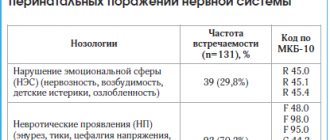Use of the drug Potassium-normine
The dose is set individually, taking into account the nature of the pathology and the level of potassium in the blood serum. The need to replenish potassium deficiency arises when its daily loss exceeds 200 µmol. To prevent potassium deficiency, 1–2 tablets are prescribed (1–2 g/day based on potassium chloride), in case of severe deficiency - 3–6 tablets. The maximum single dose is 2 tablets, the daily dose is 6 tablets. The tablets are taken during or after meals with plenty of liquid without chewing. There is no experience using the drug in children.
Potassium-normine 1 mg 30 tab.
Potassium-Normin is available in several dosage forms - tablets, solution for infusion, solution for oral administration, concentrated solution. The main active ingredient is potassium chloride, which is a source of potassium ions.
pharmachologic effect
Potassium has several important functions. It regulates water and electrolyte balance, affects the conduction of nerve impulses, activates enzymes, participates in protein synthesis, muscle contraction, etc. In small doses, potassium expands the lumen of myocardial vessels, and in large doses it leads to their narrowing. When administered simultaneously with cardiac glycosides, the toxic effect of the latter is reduced while maintaining the therapeutic effect.
Indications and contraindications
Potassium-Normin is prescribed for:
- low levels of potassium in the blood (hypokalemia), which can occur with diabetes, prolonged vomiting or diarrhea, or when taking medications that lower blood pressure and increase urine output;
- treatment of intoxication caused by taking cardiac glycosides, as well as for the prevention of this condition;
- acute myocardial infarction to prevent arrhythmia.
Contraindications for use are high levels of potassium in the blood (hyperkalemia), chronic renal failure, metabolic disorders, complete atrioventricular block, adrenal insufficiency, taking diuretics that prevent potassium leaching, ulcerative and erosive pathology of the gastrointestinal tract, pregnancy and breastfeeding.
The effectiveness and safety of the drug have not been assessed in children under 18 years of age, so this category of patients should also not take Potassium-Normin.
Side effects and overdose
Potassium-Normine can provoke the development of the following side effects:
- abdominal pain, increased gas formation, intestinal obstruction, perforation and ulcers of the gastrointestinal mucosa, nausea and vomiting, gastrointestinal bleeding;
- confusion, muscle weakness, sensory disturbance, which is manifested by a feeling of “crawling”, burning, tingling;
- decreased blood pressure, rhythm disturbances, heart block, cardiac arrest;
- allergic reactions;
- an increase in potassium levels in the blood above normal.
In case of overdose, there is a decrease in muscle tone, slowing of atrioventricular conduction, and arrhythmia. Early signs of overdose can be seen on the electrocardiogram –
expansion of the QRS complex, sharp T wave, absence of U wave, etc. With a significant increase in the level of potassium in the blood, muscle paralysis and cardiac arrest may develop. In case of overdose, infusions of saline or dextrose solution are given. If necessary, hemodialysis is prescribed.
Special instructions for the use of the drug Potassium-normine
Prescribe with caution to patients with impaired AV conduction. When using the drug in high doses (4–6 g/day), regular monitoring of potassium levels in the blood serum and periodic ECG examinations, as well as monitoring of COR, are necessary, especially in patients with diseases of the kidneys and cardiovascular system. It is also necessary to eliminate magnesium deficiency, which may accompany potassium deficiency. When conducting an X-ray examination of the abdominal organs, it should be taken into account that the drug tablet may produce a shadow on the image within 8 hours after administration.
Potassium Normin (new name Kalium R) 1g tab. No. 30 - Instructions
Dosage form
Potassium-Normin - long-acting tablets. 10 tablets in a blister; 3 blisters per package.
Compound
1 tablet of Potassium-Normin contains 1 g of potassium chloride.
Excipients: colloidal silicon dioxide, polyvinyl butyral, cetyl alcohol, magnesium stearate, talc.
Pharmacological properties
Potassium reduces the excitability and conductivity of the myocardium, weakens the toxic effect of cardiac glycosides without affecting their positive inotropic effect. In small doses, K+ dilates the coronary vessels, in large doses it narrows. Participates in the process of conducting nerve impulses. Activates many cytoplasmic enzymes, regulates intracellular osmotic pressure, protein synthesis, and amino acid transport. Improves skeletal muscle contraction in muscular dystrophy, myasthenia gravis.
Pharmacokinetics.
After oral administration, it is easily and in almost any quantity passively absorbed (absorption - 70%), because its concentration (both food and released from the dosage form) is higher in the lumen of the small intestine than in the blood. From tablets, retard is gradually and slowly released throughout the gastrointestinal tract. In the ileum and colon, K+ is released into the intestinal lumen according to the principle of coupled exchange with Na+ and is excreted with bile (10%). The distribution of K+ in the body continues for about 8 hours from the moment of administration. T1/2 in the absorption phase - 1.31 hours; release time from retard tablets is 6 hours.
Indications for use
The drug Potassium-Normin is intended for the prevention and treatment of hypokalemia of various origins, incl. caused by various conditions and diseases (vomiting, diarrhea) and due to drug therapy (diuretics, glucocorticosteroids, cardiac glycosides).
Directions for use and doses
Take Potassium-Normin tablets orally. The dose is set individually depending on the disease and the concentration of potassium in the blood plasma. 1–2 g/day (based on potassium chloride), if necessary, increase the dose to 6 g/day.
Side effects
From the gastrointestinal tract: nausea, vomiting, diarrhea, flatulence, abdominal pain, ulceration of the gastrointestinal mucosa, gastrointestinal bleeding, perforation and intestinal obstruction.
From the nervous system: paresthesia, muscle weakness, confusion.
From the cardiovascular system: decreased blood pressure, arrhythmias, heart block, cardiac arrest.
Other: hyperkalemia, allergic reactions.
Contraindications
Contraindications to the use of the drug Potassium-Normin are: hypersensitivity to the drug, hyperkalemia, complete AV block, adrenal insufficiency, chronic renal failure, concomitant therapy with potassium-sparing diuretics, metabolic disorders (acidosis, hypovolemia with hyponatremia), erosive and ulcerative lesions of the gastrointestinal tract, pregnancy, breastfeeding, age up to 18 years.
Pregnancy and breastfeeding
If it is necessary to use the drug Potassium-Normin during pregnancy, the expected benefit for the mother should be compared with the potential risk for the fetus. Breastfeeding should be stopped during treatment.
Interaction with other drugs
Potassium-sparing diuretics, potassium supplements, ACE inhibitors, and NSAIDs increase the risk of developing hyperkalemia. Reduces the side effects of cardiac glycosides. Enhances the effect of quinidine, a side effect of disopyramide.
Overdose
Symptoms of an overdose of the drug Potassium-Normin: hyperkalemia (muscle hypotonicity, paresthesia, slowing of AV conduction, arrhythmias, cardiac arrest). Early clinical signs of hyperkalemia usually appear when the serum K+ concentration is more than 6 mEq/L: sharpening of the T wave, widening of the QRS complex. More severe symptoms of hyperkalemia—muscle paralysis and cardiac arrest—develop at K+ concentrations of 9–10 mEq/L.
Treatment: orally or intravenously - sodium chloride solution; if necessary, hemodialysis and peritoneal dialysis.
special instructions
During treatment with Potassium-Normin, it is necessary to monitor the K+ content in the blood serum, ECG, and acid-base balance. The safety and effectiveness of potassium chloride in children have not been established. A diet high in sodium chloride increases the excretion of K+ from the body. It should be borne in mind that hyperkalemia, leading to death, can develop quickly and be asymptomatic.
Storage conditions
The drug Potassium-Normin should be stored in a dry place, at a temperature of 15–30 °C. Keep out of the reach of children.
Vacation category
On prescription.
Potassium-normin
Manufacturer: ICN POLFA RZESZOW SA (Poland)
tab. prolong. actions 1 g: 30 pcs. Reg. No.: P N015285/01
Clinical and pharmacological group:
A drug that replenishes potassium deficiency in the body
Release form, composition and packaging
Long-acting tablets
slightly convex on both sides, disc-shaped, white with a marble pattern, with a bitter taste, odorless; at the break - white.
| 1 tab. | |
| potassium chloride | 1 g, |
| which corresponds to the K+ content | 524.44 mg (13.3 mmol) |
Excipients:
colloidal silicon dioxide anhydrous (Aerosil A200) - 10 mg, polyvinyl butyral (Movital B30T) - 57.50 mg, cetyl alcohol - 17 mg, magnesium stearate - 1 mg, talc - 8 mg.
10 pieces. - blisters (3) - cardboard packs.
Description of the active components of the drug "Potassium-normine"
pharmachologic effect
Potassium reduces the excitability and conductivity of the myocardium, weakens the toxic effect of cardiac glycosides without affecting their positive inotropic effect.
In small doses, K+ dilates the coronary vessels, in large doses it narrows. Participates in the process of conducting nerve impulses. Activates many cytoplasmic enzymes, regulates intracellular osmotic pressure, protein synthesis, and amino acid transport. Improves skeletal muscle contraction in muscular dystrophy, myasthenia gravis.
Indications
- prevention and treatment of hypokalemia of various origins, incl. caused by various conditions and diseases (vomiting, diarrhea) and due to drug therapy (diuretics, glucocorticosteroids, cardiac glycosides).
Dosage regimen
Inside. The dose is set individually depending on the disease and the concentration of potassium in the blood plasma. 1–2 g/day (based on potassium chloride), if necessary, increase the dose to 6 g/day.
Side effect
From the gastrointestinal tract:
nausea, vomiting, diarrhea, flatulence, abdominal pain, ulceration of the gastrointestinal mucosa, gastrointestinal bleeding, perforation and intestinal obstruction.
From the nervous system:
paresthesia, muscle weakness, confusion.
From the cardiovascular system:
decreased blood pressure, arrhythmias, heart block, cardiac arrest.
Other:
hyperkalemia, allergic reactions.
Contraindications
- hyperkalemia;
- complete AV block;
- adrenal insufficiency;
— chronic renal failure;
- concomitant therapy with potassium-sparing diuretics;
- metabolic disorders (acidosis, hypovolemia with hyponatremia);
— erosive and ulcerative lesions of the gastrointestinal tract;
- pregnancy;
- breast-feeding;
— age up to 18 years;
- hypersensitivity to the drug.
Pregnancy and lactation
If use during pregnancy is necessary, the expected benefit to the mother should be compared with the potential risk to the fetus. Breastfeeding should be stopped during treatment.
Use for renal impairment
Contraindicated:
- chronic renal failure.
Application for children
The safety and effectiveness of potassium chloride in children have not been established.
special instructions
During the treatment period, it is necessary to monitor the K+ content in the blood serum, ECG, and CBS.
The safety and effectiveness of potassium chloride in children have not been established.
A diet high in sodium chloride increases the excretion of K+ from the body.
It should be borne in mind that hyperkalemia, leading to death, can develop quickly and be asymptomatic.
Overdose
Symptoms:
hyperkalemia (muscle hypotonicity, paresthesia, slowing of AV conduction, arrhythmias, cardiac arrest). Early clinical signs of hyperkalemia usually appear when the serum K+ concentration is more than 6 mEq/L: sharpening of the T wave, widening of the QRS complex.
More severe symptoms of hyperkalemia—muscle paralysis and cardiac arrest—develop at K+ concentrations of 9–10 mEq/L.
Treatment:
orally or intravenously - sodium chloride solution; if necessary, hemodialysis and peritoneal dialysis.
Drug interactions
Potassium-sparing diuretics, potassium supplements, ACE inhibitors, and NSAIDs increase the risk of developing hyperkalemia.
Reduces the side effects of cardiac glycosides.
Enhances the effect of quinidine, a side effect of disopyramide.
Conditions for dispensing from pharmacies
The drug is available with a prescription.
Storage conditions and periods
Store in a dry place at 15–30°C. Keep out of the reach of children.
Shelf life: 3 years.
Drug interactions
Potassium-sparing diuretics, potassium supplements, ACE inhibitors, and NSAIDs increase the risk of developing hyperkalemia.
Reduces the side effects of cardiac glycosides.
Enhances the effect of quinidine, a side effect of disopyramide.





